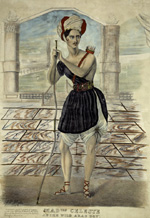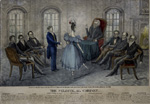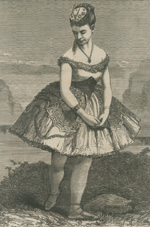America
Madame Celeste as the Wild Arab Boy in The
French Spy

Madame Celeste as the Wild
Arab Boy in The
French Spy
Lithograph by John P. Hall, New York, 1834. Beginning
in the 1820s European dancers braved long sea journeys to tour the United
States. Among the first of these pioneers was the French dancer known as
Madame Celeste, who made her American debut at the Bowery Theater, New York,
in 1827. She spent the early 1830s in Europe, performing Romantic roles
such as Fenella in
La Muette de Portici and Zoloe in
Le Dieu et
la Bayadère, which she subsequently danced on her second, extended American
tour from 1834 to 1837. Her most successful vehicle was
The French Spy,
a melodrama in which she mimed the role of a refined French lady, a dashing
cadet of the Lancers (the spy of the title), and an Arab boy who performed
a "wild" dance that unfailingly brought down the house. Trouser
roles, which bared the legs that nineteenth-century fashion covered, added
to ballet's naughty flavor. Cia Fornaroli Collection, Jerome Robbins Dance
Division.
The Celeste-al Cabinet
 Celeste-al Cabinet
Celeste-al Cabinet
Color lithograph by Henry R. Robinson, New York,
1836. During her second tour of the United States, Madame Celeste caught
the eye of President Andrew Jackson, who had a weakness for the ladies. During
the 1836 presidential campaign, the political caricaturist Henry R. Robinson
used this imaginary scene of the ballerina charming the President and his "Celeste-al
Cabinet" at the White House, to attack Jackson's candidate, Martin Van
Buren (seated on the extreme right). This is one of several exceptionally
rare American prints collected by Walter Toscanini. Cia Fornaroli Collection,
Jerome Robbins Dance Division.
Augusta Maywood
Lithograph, [Bologna], 1852. Born into a theatrical
family in New York, Augusta Maywood made her debut in Philadelphia in 1837
at the age of twelve, earning the nickname "La Petite Augusta." She
danced briefly in New York, then left for Europe, where she spent most of
her adult life. In Paris she studied with Jean Coralli and Joseph Mazilier,
and made her debut at the Opéra, partnered by Charles Mabille, with whom
she subsequently eloped. In Vienna in the mid-1840s she worked with the
Italian choreographers Antonio Guerra and Domenico Ronzani. Engaged by La
Scala in 1848, she replaced Fanny Elssler as Marguerite in Jules Perrot's Faust. (On
opening night Elssler was booed by the audience because she was Austrian. A
month later the revolt against the Austrians known as the "cinque giornate
di Milano"--the five days of Milan--would break out.) Maywood spent
the next twelve years almost exclusively in Italy, becoming a frequent guest
at La Scala (where she had a great success in Giovanni Rota's Bianchi
e Negri [Whites and Blacks]) and touring extensively with her own company. (This
print, for instance, commemorates a season in Ravenna.) The first American
dancer to win a place among Europe's top-ranking ballerinas, she excelled
at works, such as Giselle, Catarina, and Faust, that
called for expressive acting and a virtuoso technique. Cia Fornaroli Collection,
Jerome Robbins Dance Division.
Mons. Paul Taglioni, Madame Taglioni. In
the characters of La sylphide & James Reuben, at the Park-Theatre,
New York, May 22d, 1839. Principal dancers of the Opera House, [Berlin,
London, etc.].
Color lithograph by Napoleon Sarony, New York,
1839. This lithograph of Paul and Amalie Galster Taglioni commemorates their
American debut at New York's Park Theatre in 1838 as well as the first complete
production of La Sylphide in the United States. In 1832, shortly
after the ballet's premiere in Paris, Paul had danced the role of James to
his sister's Sylphide in Berlin and London, where Amalie had played the role
of Effie. Paul's New York production followed his father's Paris staging
and used the original Jean Schneizhoeffer score. Cia Fornaroli Collection,
Jerome Robbins Dance Division.
Ronzani's Grand Ballet Troupe; from the theatre
La Scala in Milan, the Royal Theatre in Turin, Her Majesty's Theatre London,
Academy of Music Philadelphia
Color lithograph by B. F. Smith, Jr., New York,
[1857]. In 1857 Domenico Ronzani, after a distinguished career as a dancer,
choreographer, and producer, assembled the finest company yet seen in the
United States to inaugurate the new Philadelphia Academy of Music. The company,
which included dancers from La Scala and other Italian theaters (in this
category were the principal mimes Cesare and Serafina Cecchetti and their
seven-year-old son Enrico), opened with Ronzani's production of Faust,
one of the many ballets by Jules Perrot that he reproduced at La Scala and
elsewhere. This lithograph, which may show a scene from the ballet, was
probably used as a poster. Cia Fornaroli Collection, Jerome Robbins Dance
Division.
M'lle Marietta Bonfanti, danseuse, leader
of the great Bonfanti ballet troupe, which will appear at the Olympic Theatre,
Monday, August 16

Bonfanti
Newspaper clipping, with a wood engraving from
a drawing by Reed, from the
Olympic Pictorial, issued by the Olympic
Theatre, Boston, 14 August 1869. Born in Milan, Maria Bonfanti trained privately
with Carlo Blasis and at La Scala. In 1860, at the age of fourteen, she
made her debut in Vercelli and, two years later, left Milan for engagements
in Lyon, Paris, London, and Madrid. In 1866 she made her New York debut
at Niblo's Garden as the prima ballerina assoluta of
The Black Crook,
a thinly plotted melodrama combining elaborate scenery, lavish costumes,
European ballerinas, and scantily clad showgirls that became the prototype
of nineteenth-century American musical spectacles. The show was a huge success,
revived again and again throughout the nineteenth century. Bonfanti remained
in the United States until the end of her life, dancing and touring in numerous
shows, appearing as prima ballerina at the new Metropolitan Opera in 1885/1886,
and eventually opening a school in New York. Jerome Robbins Dance Division.
Maria Giuri
Lithograph by Ferdinando Perrin, [Turin?, 187-?]. Born
in Milan, Maria Giuri trained with Caterina Beretta and made her debut in
Paul Taglioni's ballet Fantasca in Berlin when she was only fourteen. In
1879 she danced in the La Scala production of Luigi Manzotti's Sieba,
and, later, in the same house, in revivals of his ballets Excelsior and Pietro
Micca. In 1885 she appeared in St. Petersburg and two years later with
the National Opera Company at the Metropolitan Opera House in New York, performing
the divertissements in several operas and the role of Swanilda in Coppélia. "The
dancing of Mlle Giuri (Swanilda)," wrote The New York Times, "was
by all odds the best ever seen in this house, and, as a combination of grace,
strength, and quickness, we doubt if it has ever been surpassed in this city." Giuri
was one of numerous La Scala dancers to appear at the "old Met" in
its early decades. Cia Fornaroli Collection, Jerome Robbins Dance Division.
Rita Sangalli
Carte de visite. Photo by Fradelle & Leach, London. A student
of Auguste Hus at La Scala, Rita Sangalli starred (along with Maria Bonfanti
and Giuseppina Morlacchi) in the enormously popular, long-running spectacle The
Black Crook, which opened at Niblo's Garden Theatre in New York in
1866. Returning to Europe, she spent several seasons at the Paris Opéra,
creating (among other parts) the title role in Sylvia (1876). Walter
Toscanini Collection of Research Materials in Dance, Jerome Robbins Dance
Division.
Rosina Galli performing with her sister
Photograph, ca. 1900. Born in Milan in 1896 and trained at La Scala,
Rosina Galli (the "girl" of the twosome) spent most of her
professional life in the United States. She made her American debut
with the Chicago Grand Opera in 1911 and three years later, when the
company temporarily disbanded, accepted an engagement at the Metropolitan
Opera, where she would spend the next two decades. Until 1930, when
her marriage to the Met's general manager, Giulio Gatti-Casazza, brought
her performing career to an end, she appeared in the traditional opera-ballet
repertory in addition to performing lead roles in Adolph Bolm's stagings
of Le Coq d'Or (1918) and Petrouchka (1919), and other
ballets that acknowledged innovative trends in music and choreography. In
1919 she became the Met's ballet mistress, a position that involved teaching
as well as "compos[ing] dances for the operas, ballets, etc." (as
her contract stated). She choreographed a remarkable array of divertissements
as well as more serious works, such as the ballet La Giara (The
Jar) (1927) to music by the twentieth-century Italian composer Alfredo
Casella. By the 1930s her artistic approach, increasingly viewed as
old-fashioned, had come under criticism, and in 1935, the new Metropolitan
management, headed by Edward Johnson, engaged George Balanchine's fledgling
company, the American Ballet, to become the Met's resident dance troupe. With
the departure of Galli and Gatti-Casazza, the Italian presence at the
Met largely came to an end. Walter Toscanini Collection of Research
Materials in Dance, Jerome Robbins Dance Division.
Rosina Galli
Photo by Guigoni e Bossi, Milan. Inscribed to "my dear companion
Cia," 27 May 1910. Walter Toscanini Collection of Research Materials
in Dance, Jerome Robbins Dance Division.
"Opera Loses Singer in Gaining Star Dancer"
Clipping from Musical America,
22 Jan. 1916, with photos by Mishkin. The caption reads: "Rosina Galli, 'Première Danseuse'
of the Metropolitan Opera House, as She Appears in the Dances of 'Prince
Igor.' Her Associate is Giuseppe Bonfiglio." Although the Metropolitan
Opera House was an Italian bastion, the impact of Diaghilev's Ballets
Russes could be felt during the war years, when the company made two
heavily publicized tours of the United States that included seasons at
the Met. In fact, the Met's premiere of the Alexander Borodin opera Prince
Igor with its "Tartar Ballabile" (to the music of the Polovtsian
dances) took place only a few weeks before the Ballets Russes
performed its version of the Polovtsian Dances at New York's Century
Theatre. The
hugely popular number had figured in the Ballets Russes repertory since
1909. Walter Toscanini Collection of Research Materials in Dance, Jerome
Robbins Dance Division.